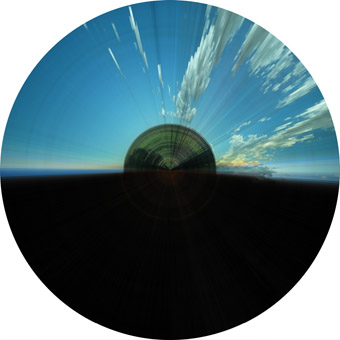digital demands & pleasures
zsuzsanna soboslay: beginning middle end, anu

Watching the Sky
Mitchell Whitelaw
Watching the Sky
BEGINNING MIDDLE END WAS AN ANU SCHOOL OF ART THREE-WEEK FORUM, FESTIVAL AND EXHIBITION OF CURRENT DIGITAL MEDIA RESEARCH AND PRAXIS WHICH DREW ACADEMICS, POST- AND UNDER-GRADUATE STUDENTS FROM A NUMBER OF AUSTRALIAN UNIVERSITIES..
The wrap-up exhibition was in various states of repair and dysfunction both times I visited, which left me to ponder the relationship between ideas and imagination, technology and affect, and how much grace we need to give works in development when they come up against their limits.
Some of the ‘game’ interactives, required me to stand at x-distance and utilise y-tools to enact z-function, rendering me as robotic as the faces twitching at me from the screen. Other exhibitors, however, were more thoughtfully at work with an awareness of exhibition space and spectator as co-significant and co-intelligent factors.
Although Ryszard Dabek’s sound was not working on one visit, still the idea of the whole worked both times. His installation, Fader (www.ryszard.net/fader), zooms detailed digital images of 1940s worker figures from Warsaw’s Plac Konstytucji against a bare white wall. A video loop of old vinyl records, “endlessly spiralling and repeating”, is complemented by a wash of sound, ghosting the space with voices and instrumental snatches. These circular and circulating images and sounds are like portals into a ship of lost ideals, reflecting on the patchiness of memory, memorial documents, art and history.
By contrast, Luke Pender’s Longing From New Holland ties my hands and my mind. He projects images of convict love tokens (small metal discs) in a rapid-shuffle video loop, below there’s a tumble of 5,000 shabby cardboard replicas in a heap on the floor. The sound component, which “deliberately overlaps messages from these tokens…making it impossible to hear each” leaves one feeling winded. The original tokens—exquisitely detailed, hand-worked and highly individuated homages to passion, hope, and craft—live down the road at the National Museum, and deserve far more honouring than this (www.nma.gov.au/exhibitions/community/australian_digital_journeys/luke_penders).
The large exhibition centrepiece, InterANTARCTICA, requires the physical presence of the audience and its bodies’ motions. Driven by a motivation to “impart vital knowledge” about climate change, this interactive work-in-progress—created by Dr onacloV, Michael Bates and 14 students from the University of Sydney Design Lab—presumes a lot about how it effects empathic reaction and supposedly manufactures a response-able relationship to this threatened environment.
I doubt empathic connection is made via manipulating the Tangible User Interfaces, which are clunky and cumbersome and just plain odd. A flashing light bulb telling me I’ve won a brownie point is not going to make me want to change my energy habits. Quite apart from how well, or otherwise, this compares with fully functioning interactives already accessible in public galleries, this interactive has a very long way to go to match the calibre of input from its sound artist—Michael Bates’ eerily evocative 3-D soundscape—or that of the awesome landscape footage gathered by CSIRO base scientists doing the ground-level research work in the Antarctic.
In its current form, and in the current exhibition, InterANTARCTICA is highly problematic (www.interantarctica.com). For full effect, it requires room lights out (bad luck for the other exhibitors). It also relies on spatial configurations to be exactly right—eg exact hanging or standing distance for the projections cameras—for which this gallery was not equipped, and which caused the install to malfunction. Multimedia can be caught in an idealised parameter which is hard to achieve and at times unreasonable to expect. Ironically, this exhibition calls attention to itself, as opposed to the subject and intention that it advocates.
Elsewhere in Beginning Middle End, Anna Madeleine’s stop-frame animation Why read the book when you can watch the movie? shows a real match between intention and achievement. The animation reveals hand drawn imagery unfolding from the pages of a book. Its visual story-within-a-story reveals multi-dimensional narratives and reflects on the intimate, interactive, trans-personal and transformative nature of reading itself. Quirky, poetic, playful, spacious, its elements playfully cross paths and challenge relationships between text and image, fiction and reality, and old and new media. (For other works by the artist: www.annamadeleine.com)
Mitchell Whitelaw’s nylon 3D print Weather Ring—“an experiment in transducing form from temporal patterns”—is perhaps the highlight of the exhibition. It presents 365 days of local weather data in a three-dimensional, ‘bracelet’ form. Its circumference texture is as intriguing as a city’s silhouette (http://teemingvoid.blogspot.com/2009/10/weather-bracelet-3d-printed-data.html). It is complemented by Whitelaw’s Watching the Sky (detail, 14/5/08), a kind of Japanese fan of inkjet-printed, composite images—1,440 to be precise—of collected data from a single 24-hour period, visualised using a simple slit-scan technique (www.flickr.com/photos/mtchl/sets/72157604494499057). Poignant and poetic, these two works are both technically and philosophically exceptional, merging the gap between hard data and sense perception, showing how our world and its changes wears at and touches us.
ANU School of Art, Beginning Middle End, digital media showcase, curator Lucien Leon, ANU School of Art Gallery, Sept 3-24, www.bmefestival.com
RealTime issue #94 Dec-Jan 2009 pg. web






